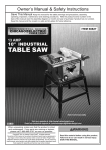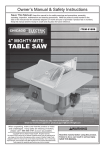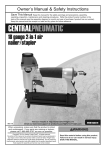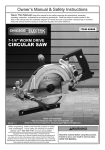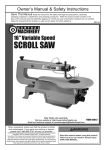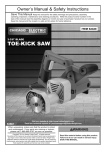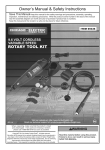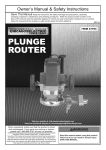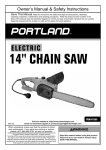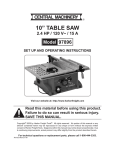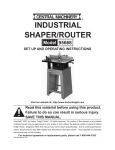Download Harbor Freight Tools 1 Horsepower Wood Shaper Product manual
Transcript
Owner’s Manual & Safety Instructions Save This Manual Keep this manual for the safety warnings and precautions, assembly, operating, inspection, maintenance and cleaning procedures. Write the product’s serial number in the back of the manual near the assembly diagram (or month and year of purchase if product has no number). Keep this manual and the receipt in a safe and dry place for future reference. Visit our website at: http://www.harborfreight.com Email our technical support at: [email protected] REV 14l When unpacking, make sure that the product is intact and undamaged. If any parts are missing or broken, please call 1-888-866-5797 as soon as possible. Copyright© 2007 by Harbor Freight Tools®. All rights reserved. No portion of this manual or any artwork contained herein may be reproduced in any shape or form without the express written consent of Harbor Freight Tools. Diagrams within this manual may not be drawn proportionally. Due to continuing improvements, actual product may differ slightly from the product described herein. Tools required for assembly and service may not be included. Read this material before using this product. Failure to do so can result in serious injury. SAVE THIS MANUAL. Table of Contents Safety Safetye��������������������������������������������������������� 2 Specifications.............................................. 7 Setup........................................................... 7 Operationa��������������������������������������������������� 15 Maintenancei���������������������������������������������� 19 Parts List and Diagrams............................. 21 Warranty..................................................... 24 WARNING SYMBOLS AND DEFINITIONS Setup This is the safety alert symbol. It is used to alert you to potential personal injury hazards. Obey all safety messages that follow this symbol to avoid possible injury or death. Indicates a hazardous situation which, if not avoided, will result in death or serious injury. Indicates a hazardous situation which, if not avoided, could result in death or serious injury. Indicates a hazardous situation which, if not avoided, could result in minor or moderate injury. Addresses practices not related to personal injury. Operation IMPORTANT SAFETY INFORMATION General Tool Safety Warnings Read all safety warnings and instructions. Failure to follow the warnings and instructions may result in electric shock, fire and/or serious injury. Save all warnings and instructions for future reference. Maintenance 1. KEEP GUARDS IN PLACE and in working order. 2. REMOVE ADJUSTING KEYS AND WRENCHES. Form habit of checking to see that keys and adjusting wrenches are removed from tool before turning it on. 3. KEEP WORK AREA CLEAN. Cluttered areas and benches invite accidents. 4. DON’T USE IN DANGEROUS ENVIRONMENT. Don’t use power tools in damp or wet locations, or expose them to rain. Keep work area well lighted. Page 2 5. KEEP CHILDREN AWAY. All visitors should be kept safe distance from work area. 6. MAKE WORKSHOP KID PROOF with padlocks, master switches, or by removing starter keys. 7. DON’T FORCE TOOL. It will do the job better and safer at the rate for which it was designed. 8. USE RIGHT TOOL. Don’t force tool or attachment to do a job for which it was not designed. For technical questions, please call 1-888-866-5797. Item 95668 0–6 18 16 16 14 6.1 – 10 18 16 14 12 10.1 – 12 16 16 14 12 12.1 – 16 14 12 Do not use. 9. USE PROPER EXTENSION CORD. Make sure your extension cord is in good condition. When using an extension cord, be sure to use one heavy enough to carry the current your product will draw. An undersized cord will cause a drop in line voltage resulting in loss of power and overheating. Table A shows the correct size to use depending on cord length and nameplate ampere rating. If in doubt, use the next heavier gauge. The smaller the gauge number, the heavier the cord. 10. WEAR PROPER APPAREL. Do not wear loose clothing, gloves, neckties, rings, bracelets, or other jewelry which may get caught in moving parts. Nonslip footwear is recommended. Wear protective hair covering to contain long hair. 11. ALWAYS USE SAFETY GLASSES. Also use face or dust mask if cutting operation is dusty. Everyday eyeglasses only have impact resistant lenses, they are NOT safety glasses. 15. DISCONNECT TOOLS before servicing; when changing accessories, such as blades, bits, cutters, and the like. 16. REDUCE THE RISK OF UNINTENTIONAL STARTING. Make sure switch is in off position before plugging in. 17. USE RECOMMENDED ACCESSORIES. Consult the owner’s manual for recommended accessories. The use of improper accessories may cause risk of injury to persons. 18. NEVER STAND ON TOOL. Serious injury could occur if the tool is tipped or if the cutting tool is unintentionally contacted. 19. CHECK DAMAGED PARTS. Before further use of the tool, a guard or other part that is damaged should be carefully checked to determine that it will operate properly and perform its intended function – check for alignment of moving parts, binding of moving parts, breakage of parts, mounting, and any other conditions that may affect its operation. A guard or other part that is damaged should be properly repaired or replaced. 20. DIRECTION OF FEED. Feed work into a blade or cutter against the direction of rotation of the blade or cutter only. 21. NEVER LEAVE TOOL RUNNING UNATTENDED. TURN POWER OFF. Don’t leave tool until it comes to a complete stop. Maintenance 12. SECURE WORK. Use clamps or a vise to hold work when practical. It’s safer than using your hand and it frees both hands to operate tool. 14. MAINTAIN TOOLS WITH CARE. Keep tools sharp and clean for best and safest performance. Follow instructions for lubricating and changing accessories. Safety (at full load) EXTENSION CORD LENGTH 25′ 50′ 100′ 150′ Setup NAMEPLATE AMPERES 13. DON’T OVERREACH. Keep proper footing and balance at all times. Operation Table A: RECOMMENDED MINIMUM WIRE GAUGE FOR EXTENSION CORDS (120 VOLT) Item 95668 For technical questions, please call 1-888-866-5797. Page 3 Grounding Instructions Safety TO PREVENT ELECTRIC SHOCK AND DEATH FROM INCORRECT GROUNDING WIRE CONNECTION READ AND FOLLOW THESE INSTRUCTIONS: 110-120 VAC Grounded Tools: Tools with Three Prong Plugs 1. In the event of a malfunction or breakdown, grounding provides a path of least resistance for electric current to reduce the risk of electric shock. This tool is equipped with an electric cord having an equipment-grounding conductor and a grounding plug. The plug must be plugged into a matching outlet that is properly installed and grounded in accordance with all local codes and ordinances. Setup 2. Do not modify the plug provided – if it will not fit the outlet, have the proper outlet installed by a qualified electrician. 3. Improper connection of the equipment-grounding conductor can result in a risk of electric shock. The conductor with insulation having an outer surface that is green with or without yellow stripes is the equipment-grounding conductor. If repair or replacement of the electric cord or plug is necessary, do not connect the equipmentgrounding conductor to a live terminal. Operation 4. Check with a qualified electrician or service personnel if the grounding instructions are not completely understood, or if in doubt as to whether the tool is properly grounded. 5. Use only 3-wire extension cords that have 3-prong grounding plugs and 3-pole receptacles that accept the tool’s plug. 6. Repair or replace damaged or worn cord immediately. Grounding Pin 125 VAC 3-Prong Plug and Outlet (for up to 125 VAC and up to 15 A) 7. This tool is intended for use on a circuit that has an outlet that looks like the one illustrated above in 125 VAC 3-Prong Plug and Outlet. The tool has a grounding plug that looks like the plug illustrated above in 125 VAC 3-Prong Plug and Outlet. 8. The outlet must be properly installed and grounded in accordance with all codes and ordinances. 9. Do not use an adapter to connect this tool to a different outlet. Shaper Router Safety Warnings For Your Own Safety Read Instruction Manual Before Operating Shaper Router 4. Do not use awkward hand positions. Maintenance 1. Wear eye protection. 5. Keep fingers away from revolving cutter – use fixtures when necessary. 2. Be sure keyed washer is directly under spindle nut and spindle nut is tight. 6. Use overhead guard when adjustable fence is not in place. 3. Feed workpiece against rotation of cutter. 7. Construct an appropriate Push Stick out of wood according to the guidelines on the following page. Page 4 For technical questions, please call 1-888-866-5797. Item 95668 Essential Straight Push-stick Features and Functions Handle Notch • Must be far enough down the stick to allow a comfortable and firm grip. Safety Note: Straight style (traditional) stick shown. A different stick design may be used if it properly protects against all hazards. Diagram not to scale. • Push sticks must be made from sturdy, defect-free, plywood or normal wood to prevent unexpected breakage. Material must be at least 1/4″ thick, but no thicker than the finished wood. • Inspect push stick before use and do not use a damaged or deteriorated push stick. • Must be deep enough to prevent hand from slipping down the stick. • Push stick dimensions will vary depending on the application and user. T NO • Corners may be rounded to increase comfort. Setup • Do not cut more than halfway into the stick to prevent weakening. TO ″ t6 as Le E. AL At • At least 6″ from end of handle to closest part of notch. SC • Must be long enough to keep hand clear of blade. Operation Stick Length 90° Notch 30°-40° Item 95668 For technical questions, please call 1-888-866-5797. Maintenance • The lower lip of the notch must be no longer than the workpiece is thick. Le wo ss th thi rkpi an ck ece ne ss • Must be right (90°) angle, cut at 30°-40° from the angle of the stick to keep hands out of the line of the blade. Page 5 8. DO NOT OPERATE WITH ANY GUARD DISABLED, DAMAGED, OR REMOVED. Moving guards must move freely and close instantly. Safety 9. The use of accessories or attachments not recommended by the manufacturer may result in a risk of injury to persons. 10. When servicing use only identical replacement parts. 11. Only use safety equipment that has been approved by an appropriate standards agency. Unapproved safety equipment may not provide adequate protection. Eye protection must be ANSI-approved and breathing protection must be NIOSH-approved for the specific hazards in the work area. Setup 12. Stay alert, watch what you are doing and use common sense when operating a power tool. Do not use a power tool while you are tired or under the influence of drugs, alcohol or medication. A moment of inattention while operating power tools may result in serious personal injury. 13. Industrial applications must follow OSHA guidelines. 14. Maintain labels and nameplates on the tool. These carry important safety information. If unreadable or missing, contact Harbor Freight Tools for a replacement. 15. Avoid unintentional starting. Prepare to begin work before turning on the tool. Operation 16. People with pacemakers should consult their physician(s) before use. Electromagnetic fields in close proximity to heart pacemaker could cause pacemaker interference or pacemaker failure. 17. WARNING: Some dust created by power sanding, sawing, grinding, drilling, and other construction activities, contains chemicals known to the State of California to cause cancer and birth defects or other reproductive harm. Some examples of these chemicals are: • Lead from lead-based paints • Crystalline silica from bricks and cement or other masonry products • Arsenic and chromium from chemically treated lumber Your risk from these exposures varies, depending on how often you do this type of work. To reduce your exposure to these chemicals: work in a well ventilated area, and work with approved safety equipment, such as those dust masks that are specially designed to filter out microscopic particles. (California Health & Safety Code § 25249.5, et seq.) 18. WARNING: The cord of this product contains lead and/or di (2-ethylhexyl) phthalate (DEHP), chemicals known to the State of California to cause cancer, and birth defects or other reproductive harm. Wash hands after handling. (California Health & Safety Code § 25249.5, et seq.) 19. The warnings, precautions, and instructions discussed in this instruction manual cannot cover all possible conditions and situations that may occur. It must be understood by the operator that common sense and caution are factors which cannot be built into this product, but must be supplied by the operator. Vibration Safety This tool vibrates during use. Repeated or long-term exposure to vibration may cause temporary or permanent physical injury, particularly to the hands, arms and shoulders. To reduce the risk of vibration-related injury: Maintenance 1. Anyone using vibrating tools regularly or for an extended period should first be examined by a doctor and then have regular medical check‑ups to ensure medical problems are not being caused or worsened from use. Pregnant women or people who have impaired blood circulation to the hand, past hand injuries, nervous system disorders, diabetes, or Raynaud’s Disease should not use this tool. If you feel any medical or physical symptoms related to vibration (such as tingling, numbness, and white or blue fingers), seek medical advice as soon as possible. 2. Do not smoke during use. Nicotine reduces the blood supply to the hands and fingers, increasing the risk of vibration-related injury. 3. Use tools with the lowest vibration when there is a choice between different processes. 4. Include vibration-free periods each day of work. 5. Grip workpiece as lightly as possible (while still keeping safe control of it). Let the tool do the work. 6. To reduce vibration, maintain the tool as explained in this manual. If any abnormal vibration occurs, stop use immediately. SAVE THESE INSTRUCTIONS. Page 6 For technical questions, please call 1-888-866-5797. Item 95668 Specifications Safety Spindle Diameter Spindle Thread Spindle Travel Router Collets Maximum Cutting Diameter Table Size Footprint Miter Guide Fence Dimensions Overall Dimensions Gross Weight 110 VAC / 60 Hz / 10.54 Amps (With Load) Motor Size: 1 HP / Single Phase Motor RPM: 3450 Spindle Speed: 11,000 Power Cord Length: 70″ Power Cord Specifications: SJT 16 AWG x 3C Plug Type: 3 Prong / Grounded 1/2″ 12mm x 1.5 pitch, fine thread 7/8″ ¼″ and ½″ (included) 2-7/8″ 24″ Wide x 19″ Deep 18-7/8″ Wide x 16-5/8″ Deep 0 ~ 60° Left to Right 9/16″ Long x 11-3/4″ Wide x 2-3/4″ High (Qty. 2) 26-1/8″ Long x 27-1/2″ Wide x 36-1/2″ High 187.5 Lb. Setup Electrical Requirements Setup - Before Use: Read the ENTIRE IMPORTANT SAFETY INFORMATION section at the beginning of this manual including all text under subheadings therein before set up or use of this product. Note: For additional information regarding the parts listed in the following pages, refer to the Assembly Diagram near the end of this manual. Assembly/Mounting Stand Assembly SIDE PANEL (1) 1. Lay one Side Panel (1) on the floor and attach the Tie Bars (2) with the Carriage Bolts (9), 3/8″ Flat Washers (10), and Nuts (11). Do not fully tighten the Bolts and Nuts at this time. Operation TO PREVENT SERIOUS INJURY FROM ACCIDENTAL OPERATION: Turn the Power Switch of the tool off and unplug the tool from its electrical outlet before performing any procedure in this section. CARRIAGE BOLTS (9) 3/8″ FLAT WASHERS (10) NUTS (11) Maintenance SIDE PANEL (1) TIE BAR (2) TIE BAR (2) RUBBER FEET (3) Figure A Figure B 2. Attach the second Side Panel (1) to the assembly. Item 95668 For technical questions, please call 1-888-866-5797. Page 7 STAND ASSEMBLY Safety (28) (28) (28) WORK TABLE (52) Figure C 3. Attach the four Rubber Feet (3) to the bottom of the Side Panels (1). Setup 4. Place the Wood Shaper’s Work Table (52) upside down on two sturdy blocks that are at least 3-1/2″ off the floor. Make sure the Spindle (105) DOES NOT touch the floor or the weight of the Wood Shaper may damage the Spindle. Figure D 5. Place the Stand assembly on the Wood Shaper and attach it with the Carriage Bolts (9), 3/8″ Flat Washers (10), and Nuts (11). Then have an assistant help you turn the Wood Shaper unit upright. 6. Level the Wood Shaper with a carpenter’s level. If necessary, move the Stand slightly until it is level. Then, tighten all Bolts and Nuts on the Stand. Optional Table Spacer Installation 1. Your shaper comes with a Table Spacer Installation Kit that will enable you to make shallow cuts and utilize the upper blade area of most router bits with standard-length shanks. This is an optional feature that is not required for most applications. Operation 2. Unplug the shaper power cord. Remove the four table corner Bolts (66), then remove the three Spindle Housing Bolts (95). Lift the Table (52) off of the stand assembly. 3. Locate the package, (included with your shaper), that contains all the hardware for installing the spacers. There should be five M12 Long Bolts (151), two M12 Short Bolts (152) and seven 1/2″ Spacers (150). Position one spacer over each of the four corner bolt holes and one over each of the three spindle housing bolt holes. 4. Carefully place the Table (52) over the Table Legs (28). Secure the Table (52) using two Short Bolts (152) and washers (65) in the front of the shaper, and five Long Bolts (151) and Washer (65) for the rear corners and for the spindle housing. Installing The Fences Using the Cross Head Screws (12) and Washers (13), install each Fence (60) to the Right and Left Fence Bodies (57, 59). Make sure the Screwheads are countersunk completely below the surface of the Right and Left Fence Bodies (57, 59). FENCE (60) RIGHT FENCE BODY (not Shown) (57) LEFT FENCE BODY (59) Maintenance CROSS HEAD SCREWS (12) WASHERS (13) Figure E Page 8 For technical questions, please call 1-888-866-5797. Item 95668 Installing The Safety Guard HOLD DOWN BAR (77) RING GUARD (85) CROSS HEAD SCREWS (78) NUTS (84) 2. Connect the Hold Down Bar (77) to the Ring Guard (85) with two Cross Head Screws (78) and two Nuts (84) 3. Position the Hold Down Bar (77) and Ring Guard (85) on the Housing Bracket (87) and install the Hex Post (79) on the Mounting Bracket (82). Safety 1. Connect the Hold Down Bar (77) to the Hex Post (79) with two Bolts (75) and two Flat Washers (76). HOUSING BRACKET (87) MOUNTING BRACKET (82) Figure F Installing The Spindle 2. Thread one end of the Draw Bar (121) into the bottom end of the Spindle (105) approximately 10 to 15 turns until tight. 4. Thread the tapered Draw Bar Nut (122) onto the end of the Draw Bar (121) under the Work Table (52), making sure the tapered side of the Nut is facing upward. Setup 1. Remove any oil, grease, dirt and debris from the Spindle (105), Draw Bar (121), and Spindle Housing (110) surfaces before installing the Spindle. SPINDLE (105) Operation DRAW BAR NUT (122) DRAW BAR (121) Figure I 5. Place a wrench (not included) on the top end of the Spindle (105). Figure G 3. Insert the Spindle/Draw Bar assembly into the Spindle Housing (110) from the top side of the Work Table (52). 6. Using an open-end wrench (not included), tighten the Draw Bar Nut (122) while holding the Spindle (105) securely. DO NOT over-tighten the Draw Bar Nut. SPINDLE HOUSING (110) Figure H Item 95668 Maintenance SPINDLE (105) DRAW BAR NUT (122) Figure J For technical questions, please call 1-888-866-5797. Page 9 Router Bit Assembly 1. Prior to installation, remove any oil, grease, dirt and debris from the Collet (103/104), Draw Bar (121), and Spindle Housing (110) surfaces before installing a Router Bit. Safety 2. Remove the Spindle (105) if installed, follow the reverse of instructions from page 9. SPINDLE HOUSING (110) 5. Insert the Router Bit (not included) into the center of the Collet (103/104). 6. Hold the flat edge on the Spindle Housing (110) with the Arbor Wrench (146), and tighten the Collet Nut (102). COLLET (103, 104) ROUTER BIT (not included) COLLET NUT (102) Figure K 3. Insert the selected Collet (103/104) into the Collet Nut (102), broad end first, until it snaps together. SPINDLE HOUSING FLAT EDGE Setup Figure M 7. Rotate the assembly by hand, making sure the Collet (103/104) and bit rotate freely on center. Figure L: Collet Assembly Operation 4. Insert the Collet assembly into the Spindle Housing (110), and thread it into place by hand. 8. WARNING! When using a Router Bit, operate the Wood Shaper only in a counterclockwise direction. Router Bits are designed to cut in the counterclockwise direction only. DO NOT operate the Wood Shaper in the clockwise direction. If this warning is ignored, the workpiece can kickback. The Collet Nut (102) can loosen and throw the Router Bit, causing severe injury. Maintenance Page 10 For technical questions, please call 1-888-866-5797. Item 95668 Adjustment Instructions Safety TO PREVENT SERIOUS INJURY FROM ACCIDENTAL OPERATION: Turn the Power Switch of the tool off and unplug the tool from its electrical outlet before performing any procedure in this section. Fence Positioning 1. The two Fences (60) are independently adjustable to allow for different shaping tasks. The Fences (60) can be set at different positions to remove material from the entire edge of the wood stock or set at the same position to shape part of the edge. FENCE (60) FENCE (60) 2. Loosen the Lock Handle (61). 4. Once the Fence (60) is in the desired position, re-tighten the Lock Handle (61). LOCK HANDLE (61) Setup 3. Adjust the position of the Fence (60) by turning the Knob (64). KNOB (64) Figure N Fence Alignment FENCE (60) 2. If the Fences (60) are not parallel, place shims (not included) between the back of the Fence and the face of the Right or Left Fence Body (57, 59). FENCE (60) Operation 1. To align the Fences (60) so they are parallel with each other, use a straightedge that is long enough to span the entire length of the two Fences (60). STRAIGHTEDGE (NOT INCLUDED) Figure O Table Inserts TABLE INSERT (53, 53A) Maintenance 1. Table Inserts (53, 53A) are used to reduce wood chips falling into the machine which could cause flying debris. Using the smallest Table Insert also covers any unused portion of the bit below the surface of the Work Table (52). 2. Position, and snap in the Table Insert (53, 53A) you wish to use. 3. Make sure the Table Insert (53, 53A) is seated and flush with the Work Table (52) surface. WORK TABLE (52) Figure P Item 95668 For technical questions, please call 1-888-866-5797. Page 11 Belt Adjustment The Wood Shaper uses a Belt (123) on two Pulleys (113, 127) to compensate for different Belt positions as the Spindle (105) height is adjusted. To adjust the V-Belt: Safety Loosen the two Hex Head Screws (134). Slide the Motor (129) position to increase or decrease V-Belt (123) tension, so that the Belt is snug with about 1/4″ deflection when pressed lightly with your finger. Then, retighten the Hex Head Screws. V-BELT (123) HEX HEAD SCREW (134) MOTOR (129) Cutter Direction Setup 1. The Wood Shaper is capable of operating in two directions by the use of the Forward/Reverse Switch (144). It is very important that the workpiece be fed against the direction of the Cutter rotation. (Cutter not included) 2. When the Forward/Reverse Switch (144) is pointing to the FWD position, the Spindle (105) and Cutter rotate counterclockwise. FORWARD/REVERSE SWITCH (144) 3. When the Forward/Reverse Switch (144) is pointing to the REV position, the Spindle (105) and Cutter rotate clockwise. Operation 4. Always try to operate the Wood Shaper so the wood is cut from the underside. Underside cutting is much safer for the operator because when the wood is cut on the top side, the Cutter can lift and grab the wood and cause possible injury to the operator. Figure Q Cutter Installation: 1. Slide the Cutter (not included) onto the Spindle (105), making sure the rotation is correct for the specific application. 2. Place the required spacers, also called Rub Collars (98, 99, 100), onto the Spindle (105). 3. Install the Keyed Washer (97) and Upper Spindle Nut (96) securely. Tighten the Upper Spindle Nut with an open-end wrench while holding the Spindle (105) at the top with a smaller open-end wrench (both sold separately). KEYED WASHER (97) SPINDLE (105) RUB COLLARS (98, 99, 100) Maintenance CUTTER (NOT INCLUDED) UPPER SPINDLE NUT (96) Figure R Page 12 Figure S For technical questions, please call 1-888-866-5797. Item 95668 4. Check to make sure the Cutter (not included) will rotate in the correct direction. WRENCH Safety UPPER SPINDLE NUT (96) Figure T 3. Move the Spindle Height Knob (120) to the right to raise the Spindle (105) or to the left to lower the Spindle (105). 2. Loosen the Spindle Hand Knob (92) located on the side of the Wood Shaper. SPINDLE HAND KNOB (92) SPINDLE HEIGHT KNOB (120) Figure V Figure U 4. Retighten the Spindle Hand Knob (92) on the side of the Wood Shaper. DO NOT overtighten the Knob. Only a small amount of tension is needed to keep the Spindle (105) from moving during operation. Operation 1. Correct Spindle (105) height is crucial to most shaping applications. Make sure to use a piece of scrap wood to confirm the correct Spindle height before cutting expensive lumber. Setup Setting Spindle Height 1. When shaping workpieces that have irregular shapes, Rub Collars (98, 99, 100) are a necessity. Some examples of when you would use a Rub Collar are raising arched or tombstone door panels, round table tops, or any other cut that needs to have its depth of cut limited. 2. There are three set-up positions for Rub Collars (98, 99, 100): a. Above the Cutter: This set-up is the safest and produces a most consistent result. The only drawback is that the cut is on the underside of the workpiece, out of view of the operator. However, if the workpiece lifts off the Work Table (52) you simply run it through a second time to finish the cut. Item 95668 RUB COLLAR (98, 99, 100) ABOVE CUTTER Figure W For technical questions, please call 1-888-866-5797. Page 13 Maintenance Rub Collars Safety b. Between two Cutters: This set-up has the advantage of making two profile cuts in a single pass. Although there is a Rub Collar (98, 99, 100) beneath a Cutter, this set-up is safer than the previous set-up. Any lifting of the workpiece will still cause the Cutter to make an uneven cut. A second pass will correct the profile on the bottom edge, but the top profile will still have the gouge from lifting the workpiece into the Cutter. CUTTER RUB COLLAR (98, 99, 100) BETWEEN CUTTER Setup Figure X c. Below the Cutter: This set-up allows the cut to be viewed by the operator. However, it is also the most dangerous. Any slight lifting of the workpiece will cause the Cutter to make too deep of a cut. There is also increased risk of kickback. It is NOT recommended to shape with a Rub Collar below the Cutter. NOT RECOMMENDED RUB COLLAR (98, 99, 100) CUTTER BELOW Operation Figure Y Maintenance Page 14 For technical questions, please call 1-888-866-5797. Item 95668 Operating Instructions Read the ENTIRE IMPORTANT SAFETY INFORMATION section at the beginning of this manual including all text under subheadings therein before set up or use of this product. Safety Tool Set Up TO PREVENT SERIOUS INJURY FROM ACCIDENTAL OPERATION: Turn the Power Switch of the tool off and unplug the tool from its electrical outlet before performing any procedure in this section. 1. Once assembly is complete and all adjustments have been made, the Wood Shaper is ready for start up. Always pay attention to any unusual noises and vibrations on every start up, as well as making sure the Wood Shaper operates as intended. 2. Make sure the Fences (60), any accessories, jigs, Spindle Cutter, or Router Bit Collet Nut (102) being used are tight and no loose items are on the Work Table (52). 3. Make sure the Forward/Reverse Switch (144) is set to the correct direction for the Cutter installed. 4. Plug the Wood Shaper’s Power Cord (22) into the nearest 110 volt, grounded, electrical outlet. Then, start the Wood Shaper by flipping the Power Switch (5) to the “ON” position. 5. Once the machine is running, listen for any unusual noises. The Wood Shaper should run smoothly with little or no vibrations. Setup TO PREVENT SERIOUS INJURY: DO NOT OPERATE WITH ANY GUARD DISABLED, DAMAGED, OR REMOVED. Moving guards must move freely and close instantly. WARNING! If there is an unusual noise or vibration, shut off the machine immediately. DO NOT use the Wood Shaper any further until the problem(s) is corrected. If the problem(s) continues and cannot be easily identified, have a qualified service technician check out the machine. 1. Because the Wood Shaper’s Fences (60) are independently adjustable, you can set up the machine to cut part or all of the workpiece edge. FENCE (60) INFEED SIDE Operation To Set Up The Wooden Fences For Straight Shaping FENCE (60) OUTFEED SIDE 2. WARNING! DO NOT use the Miter Gauge (45) in conjunction with the Fences (60). The Fences may not be parallel to the miter slot, and binding of the workpiece could result. 3. To set up the Fences (60) for cutting material from the whole edge of the workpiece, follow the steps below. 5. Turn the Hand Knob (68) and adjust the infeed Fence (60) until the workpiece contacts the Cutter at the desired location. 6. Tighten the Lock Handle (61) to lock the infeed Fence (60) in position. LOCK HANDLE (61) HAND KNOB (68) Figure Z 7. Adjust the outfeed Fence (60) so that it is located as far back from the front of the Work Table (52) as possible. 8. Turn on the Wood Shaper. 9. Using a piece of scrap wood, advance the workpiece 8″ into the Cutter and turn off the machine. DO NOT remove the workpiece from the infeed Fence (60). Item 95668 For technical questions, please call 1-888-866-5797. Page 15 Maintenance 4. Loosen the Lock Handle (61). 10. Once the Cutter has come to a complete stop, adjust the outfeed Fence (60) so that it just touches the newly cut edge of the workpiece. Always follow the direction of feed as shown in Figure AA. (GUARD NOT SHOWN FOR CLARITY) Safety 11. Check to make sure all Aluminum Fence Lock Handles (61) are tight before proceeding to finish the cut. INPUT FEED DIRECTION OF FEED OUTPUT FEED Figure AA To Set Up The Aluminum Fences For Partial Edge Removal 1. WARNING! ALWAYS use the aid of a jig (not included) when shaping small or narrow workpieces. A jig will reduce the chance of your hands coming into contact with the Cutter. Setup 2. Loosen the Lock Handle (61). GUARD NOT SHOWN FOR CLARITY OUTPUT FEED INPUT FEED 3. Turn the Hand Knob (68) and adjust the infeed Fence (60) until the workpiece contacts the Cutter at the desired location. 4. Retighten the Lock Handle (61) to lock the infeed Fence (60) in position. 5. Adjust the outfeed Fence (60) so that it comes into alignment with the infeed Aluminum Fence (60). DIRECTION OF FEED Figure AB GUARD NOT SHOWN FOR CLARITY Operation 6. Place a straight edge against the infeed and outfeed Aluminum Fences (60) to check alignment. Once they are both in alignment, make sure the Lock Handle (61) is tightened. 7. Always feed the wood against the rotation of the Cutter. Also, examine the grain on the side edge of the board. Whenever possible, run the board so the Cutter is cutting with the grain. DIRECTION OF FEED Figure AC Workpiece and Work Area Set Up 1. Designate a work area that is clean and well‑lit. The work area must not allow access by children or pets to prevent distraction and injury. Maintenance 2. Route the power cord along a safe route to reach the work area without creating a tripping hazard or exposing the power cord to possible damage. The power cord must reach the work area with enough extra length to allow free movement while working. 3. There must not be objects, such as utility lines, nearby that will present a hazard while working. Page 16 For technical questions, please call 1-888-866-5797. Item 95668 1. Freehand shaping is shaping without the aid of the Miter Gauge (45) or Aluminum Fences (60). The most dangerous part of shaping freehand is beginning the cut, where the Cutter first contacts the workpiece. Often, the workpiece will tend to jerk or kickback, catching the operator off guard. 3. To set up the Wood Shaper for freehand shaping, remove the Fences (60) from the machine. 2. To reduce this tendency, use a Taper Pin (56). The Taper Pin allows you to anchor and slowly pivot the workpiece into the Cutter as the cut is started. Thus, shaping freehand is more stable and safer. 5. Install the Cutter so it will cut in the correct direction. Then, adjust the Spindle (105) height. WARNING! ALWAYS use an auxiliary jig (not included) and extreme care when shaping with the Fences (60) removed. Freehand shaping often requires you to remove the Fences, resulting in reduced protection from the Cutter. 4. Insert the Taper Pin (56) in the best suited hole on the Work Table (52) so you can feed the workpiece into and against the rotation of the Cutter. Safety Freehand Shaping 6. Install the Ring Guard (85). DO NOT use the Wood Shaper without the Ring Guard installed. 7. Use a supplemental hold-down jig (not included), or you can use rubberized-handle push blocks (not included) to support or guide the workpiece and protect your hands. TAPER PIN (56) SWING ROTATION RUB COLLAR (98, 99, 100) 9. Slowly pivot and feed the workpiece into the Cutter. Avoid starting the cut on the corner of the workpiece as kickback could occur. Once the cut is started, the workpiece should be pulled away from the Taper Pin (56). Setup 8. Place the workpiece against the Taper Pin (56). WORKPIECE FEED Maintenance Operation Figure AD Item 95668 For technical questions, please call 1-888-866-5797. Page 17 Pattern Shaping Safety 1. Sometimes the location of the Taper Pin (56) holes on the Work Table (52) will not always be in the safest position. You can clamp a piece of scrap wood to the Work Table so the edge of the scrap wood can be used as the starting support. 2. The use of patterns (templates) allows identical parts to be cut with speed and accuracy. Shaping with a pattern begins by attaching a prefabricated template to the rough workpiece. The edge of the template rides against a Rub Collar (98, 99, 100) on the Spindle (105) as the Cutter cuts the matching profile on the workpiece edge. Also, you can incorporate extra features into the template assembly (such as toggle clamps - not included) to hold the workpiece or you can use custom guards for safety and protection. 7. Install hold-down clamps (not included) at three sides of the pattern assembly, or screw the pattern assembly to the back side of the workpiece. PUSH BLOCK (NOT INCLUDED) SCRAP WOOD Setup CAUTION! Make sure to design jigs and fixtures so screws and clamps DO NOT contact the Cutter and the workpiece is held securely to the jig. The jig must be stable on the Work Table (52). 3. To make a template, design the assembly so that cutting will occur underneath the workpiece. Make sure screws or clamps will not come into contact with the Cutter. Figure AE TEMPLATE RUB COLLAR (98, 99, 100) 4. Make handles for safety and control. 5. Use materials that will move easily across the Work Table (52) surface and Rub Collar (98, 99, 100). Operation 6. Remember to consider the Cutter and Rub Collar (98, 99, 100) diameter when making the pattern. Figure AF WARNING! To prevent accidents, turn off the tool and unplug the tool from its electrical outlet after use. Clean, then store the tool indoors out of children’s reach. Maintenance Page 18 For technical questions, please call 1-888-866-5797. Item 95668 Maintenance and Servicing Safety Procedures not specifically explained in this manual must be performed only by a qualified technician. TO PREVENT SERIOUS INJURY FROM ACCIDENTAL OPERATION: Turn the Power Switch of the tool off and unplug the tool from its electrical outlet before performing any procedure in this section. TO PREVENT SERIOUS INJURY FROM TOOL FAILURE: Do not use damaged equipment. If abnormal noise or vibration occurs, have the problem corrected before further use. Cleaning, Maintenance, and Lubrication • loose hardware, • misalignment or binding of moving parts, 3. Periodically, wear ANSI‑approved safety goggles and NIOSH‑approved breathing protection and blow dust out of the motor vents using dry compressed air. • damaged electrical wiring, and 4. To store, keep the machine in a clean, dry, safe location out of reach of children and other unauthorized people. • any other condition that may affect its safe operation. 5. • cracked or broken parts, WARNING! If the supply cord of this power tool is damaged, it must be replaced only by a qualified service technician. Maintenance Operation 2. AFTER USE, wipe external surfaces of the tool with clean cloth. Setup 1. BEFORE EACH USE, inspect the general condition of the tool. Check for: Item 95668 For technical questions, please call 1-888-866-5797. Page 19 Troubleshooting Problem Possible Reason Possible Solution Safety Setup The Wood Shaper does not Electrical supply circuit has low Make sure machine is plugged into a working, start or the circuit breaker trips. voltage or high resistance. 110 volt, grounded, electrical outlet. The Wood Shaper runs slow. 1. Electrical supply circuit has low 1. Make sure machine is plugged voltage or high resistance. into a working, 110 volt, grounded, electrical outlet. 2. The V-Belt is slipping. 2. Adjust V-Belt tighter, or replace Belt. The Wood Shaper 1. The Stand of the Wood Shaper 1. Stabilize the Stand on the floor. vibrates. The is unstable and wobbles. Spindle is loose. Or the 2. The Spindle or Cutter is 2. Reinstall the Spindle and/or Cutter. Cutter “chatters”. loose or out of alignment. 3. The Wood Shaper has a loose 3. Have a qualified service technician Motor or Spindle Cartridge. check Motor and/or Spindle Cartridge. The Forward/Reverse Switch Defective Forward/Reverse Immediately turn off machine and unplug does not operate properly. Switch. it from its electrical outlet. Do not operate machine until a qualified service technician repairs or replaces Forward/Reverse Switch. The Power Switch does Defective Power Switch. Immediately unplug machine from its not turn off Machine. electrical outlet. Do not operate machine until a qualified service technician repairs or replaces Power Switch. Follow all safety precautions whenever diagnosing or servicing the tool. Disconnect power supply before service. Operation Maintenance Page 20 For technical questions, please call 1-888-866-5797. Item 95668 Parts List and Diagrams THE MANUFACTURER AND/OR DISTRIBUTOR HAS PROVIDED THE PARTS LIST AND ASSEMBLY DIAGRAM IN THIS MANUAL AS A REFERENCE TOOL ONLY. NEITHER THE MANUFACTURER OR DISTRIBUTOR MAKES ANY REPRESENTATION OR WARRANTY OF ANY KIND TO THE BUYER THAT HE OR SHE IS QUALIFIED TO MAKE ANY REPAIRS TO THE PRODUCT, OR THAT HE OR SHE IS QUALIFIED TO REPLACE ANY PARTS OF THE PRODUCT. IN FACT, THE MANUFACTURER AND/OR DISTRIBUTOR EXPRESSLY STATES THAT ALL REPAIRS AND PARTS REPLACEMENTS SHOULD BE UNDERTAKEN BY CERTIFIED AND LICENSED TECHNICIANS, AND NOT BY THE BUYER. THE BUYER ASSUMES ALL RISK AND LIABILITY ARISING OUT OF HIS OR HER REPAIRS TO THE ORIGINAL PRODUCT OR REPLACEMENT PARTS THERETO, OR ARISING OUT OF HIS OR HER INSTALLATION OF REPLACEMENT PARTS THERETO. Safety PLEASE READ THE FOLLOWING CAREFULLY Setup Wiring Diagram GREEN BLACK MOTOR GREEN BLACK Operation Disconnect power from machine before performing any electrical service. Failure to do this will result in a shock hazard leading to injury. WHITE POWER SWITCH WHITE CAPACITOR BLACK BLACK BLACK WHITE WHITE RED REAR VIEW OF SWITCH FWD/REV SWITCH REAR VIEW OF SWITCH Item 95668 For technical questions, please call 1-888-866-5797. Page 21 Maintenance WHITE Parts List Part Safety 1 2 3 4 5 6 7 8 9 10 11 12 Setup 13 14 15 16 18 19 20 21 22 23 26 27 28 30 31 32 33 34 35 Operation 36 37 Maintenance 38 39 40 41 42 43 44 44A 45 46 47 48 49 50 51 52 53 53A Description Side Panel Tie Bar Rubber Foot Cross Head Screw (M4-0.7x25) Power Switch Switch Lamella Flat Washer (5mm) Nut (M4-0.7) Carriage Bolt (M8-1.25 x 12) Flat Washer (3/8″) Nut (M8-1.25) Cross Head Screw (M5-0.8 x 12) Exterior Tooth Washer (5mm) Nut (M5-0.8) Shelf Electricity Label Nut (M8-1.25) Flat Washer (3/8″) Strain Relief Spindle Pulley Guard Power Cord Wire Cord Flat Washer (3/8″) Bolt (M8-1.25 x 12) Table Leg Bolt (M8-1.25 x 25) Bolt (M12-1.75 x 30) Lock Washer (12mm) Table Support Miter Block Flat Washer (1/4″) Cross Head Screw (M4-0.7 x 6) Self Tapping Screw (3.5 x 12mm) Flat Washer (3/8″) Support Pole Stud Bolt Anti-Kickback Pin Miter Bar Aluminum Alloy Fence Right Fence Lid Left Fence Lid Miter Gauge Body Handle Pointer Self Tapping Screw (M3 x 15) Tension Pin (2 x 16mm) Carriage Bolt (M6-1 x 35) Knob (M6-1.0) Work Table Table Insert (1-3/8″ Hole) Table Insert (1-3/4″ Hole) Page 22 Part 54 55 56 57 58 59 60 61 62 63 64 65 66 67 68 69 70 71 72 73 74 75 76 77 78 79 80 81 82 83 84 85 86 87 88 89 90 91 92 93 94 95 96 97 98 99 100 101 102 103 104 Description Carriage Bolt (M6-1 x 35) Knob (M6-1.0) Taper Pin (8 x 75mm) Fence Body (Right) Clamp Stud Fence Body (Left) Fence Lock Handle Flat Washer (1/2″) Flat Washer (3/8″) Knob (M8-1.25) Lock Washer (1/2″) Bolt (M12-1.75 x 20) Adjusting Screw Stud Hand Knob Roll Pin (3 x 20) Cross Head Screw (M6-1 x 12) Half Collar Adjusting Shaft Flat Washer (1/2″) Nut (M12-1.75) Bolt (M8-1.25 x 12) Flat Washer (3/8″) Hold Down Bar Cross Head Screw (M4-0.7 x 10) Hex Post Nut (M8-1.25) Flat Washer (3/8″) Mounting Bracket Hand Knob Nut (M4-0.7) Ring Guard Bolt (M8-1.25 x 30) Housing Bracket Clamp Sleeve (Left) Stuff Ring Roll Pin (3 x 20mm) Lock Bar Hand Knob Roll Pin (3 x 20mm) Lock Nut Bolt (M12-1.75 x 30) Upper Spindle Nut Keyed Washer Rub Collar (1/2″ x 1-3/16″ x 3/16″) Rub Collar (1/2″ x 1-3/16″ x 1/4″) Rub Collar (1/2″ x 1-3/16″ x 3/8″) Cutter Spindle Collet Nut Collet Collet Part 105 106 107 108 109 110 111 112 113 114 115 116 117 118 119 120 121 122 123 124 125 126 127 128 129 129-1 129-2 129-3 129-4 129-5 130 131 132 133 134 135 136 137 138 139 140 141 142 143 144 145 146 147 148 149 150 151 152 For technical questions, please call 1-888-866-5797. Description Spindle Key (4 x 4 x 20mm) Interior Retaining Ring (47mm) Wave Washer (45mm) Ball Bearing Spindle Housing Ball Bearing Sleeve Ball Bearing Spindle Pulley Lower Spindle Nut Bearing Cone Coil Spring Set Screw (M8-1.25 x 8) Spring Collar Stud Knob Draw Bar (M8-1.0) Draw Bar Nut (M8-1.0) Belt (690 x 10mm) Bolt (M8-1.25 x 12) Flat Washer (3/8″) Belt Guard Motor Pulley Set Screw (M6-1 x 10) Motor Start Capacitor Capacitor Cover Wiring Box Motor Fan Motor Fan Cover Key (5 x 5 x 22mm) Carriage Bolt (M8-1.25 x 40) Lock Washer (8mm) Flat Washer (3/8″) Hex Head Screw (M12-1.75 x 35) Flat Washer (1/2″) Motor Mount Plate Flat Washer (3/8″) Nut (M8-1.25) Lock Washer (12mm) Lock Washer (8mm) Flat Washer (1/4″) Shim Cross Head Screw (M6-1 x 12) Forward/Reverse Switch Switch Bracket Arbor Wrench Tap Screw (M3.5 x 12) Right Fence Lid Left Fence Lid 1/2″ Spacer Long Bolt M12 x 1.75 x 40 Short Bolts M12 x 1.75 x 30 Item 95668 148 147 Safety Assembly Diagram 55 54 Operation Setup 149 Maintenance 146 Record Product’s Serial Number Here: Note: If product has no serial number, record month and year of purchase instead. Note: Some parts are listed and shown for illustration purposes only, and are not available individually as replacement parts. Item 95668 For technical questions, please call 1-888-866-5797. Page 23 Limited 90 Day Warranty Harbor Freight Tools Co. makes every effort to assure that its products meet high quality and durability standards, and warrants to the original purchaser that this product is free from defects in materials and workmanship for the period of 90 days from the date of purchase. This warranty does not apply to damage due directly or indirectly, to misuse, abuse, negligence or accidents, repairs or alterations outside our facilities, criminal activity, improper installation, normal wear and tear, or to lack of maintenance. We shall in no event be liable for death, injuries to persons or property, or for incidental, contingent, special or consequential damages arising from the use of our product. Some states do not allow the exclusion or limitation of incidental or consequential damages, so the above limitation of exclusion may not apply to you. THIS WARRANTY IS EXPRESSLY IN LIEU OF ALL OTHER WARRANTIES, EXPRESS OR IMPLIED, INCLUDING THE WARRANTIES OF MERCHANTABILITY AND FITNESS. To take advantage of this warranty, the product or part must be returned to us with transportation charges prepaid. Proof of purchase date and an explanation of the complaint must accompany the merchandise. If our inspection verifies the defect, we will either repair or replace the product at our election or we may elect to refund the purchase price if we cannot readily and quickly provide you with a replacement. We will return repaired products at our expense, but if we determine there is no defect, or that the defect resulted from causes not within the scope of our warranty, then you must bear the cost of returning the product. This warranty gives you specific legal rights and you may also have other rights which vary from state to state. 3491 Mission Oaks Blvd. • PO Box 6009 • Camarillo, CA 93011 • 1-888-866-5797
























